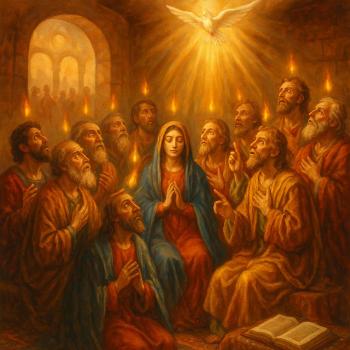 It is a great joy to read the words of another mystical author, Julian of Norwich, flowing through the creative and mystical translating of Mirabai Starr. Her translation of The Showings of Julian of Norwich is exquisite and inspiring. I know Mirabai and count her as a friend, and recognize that her words come from deep within, from the still small voice, as the original author’s wisdom bursts from through her. Her translation is truly holy and speaks to the spiritual landscape of our time. Form and content meet in Mirabai Starr’s own mystical renderings.
It is a great joy to read the words of another mystical author, Julian of Norwich, flowing through the creative and mystical translating of Mirabai Starr. Her translation of The Showings of Julian of Norwich is exquisite and inspiring. I know Mirabai and count her as a friend, and recognize that her words come from deep within, from the still small voice, as the original author’s wisdom bursts from through her. Her translation is truly holy and speaks to the spiritual landscape of our time. Form and content meet in Mirabai Starr’s own mystical renderings.
One of my favorite passages from Julian of Norwich is Dame Julian’s description of a hazelnut. Like Jesus’ parable of the mustard seed, Julian’s Hazelnut is a trifling thing and to the superficial eye one of God’s most modest creations. Yet, God shows it to Julian as a sign of God’s love for creation. I don’t eat many hazelnuts, except perhaps in an occasional Ferrero Rocher candy, Fangelico or Nutella. Still, as Jesus pioneered in his own reflections, the least of things can yield a mystical vision. God is wholly-here and wholly-now. The fullness of God bursts forth in a humble hazelnut.
According to Julian, as she gazes upon a hazelnut God placed in her hand, she hears God describe it thusly: It is all that is created….It lasts, and lasts forever, because God loves it. Everything that is, has its being through the love of God. God creates, loves, and sustains hazelnuts and all creation, one microsecond at a time.
Julian’s vision of the hazelnut points to one of the most important, yet challenging, aspects of God’s creativity, God’s omnipresence. Put, simply divine omnipresence means that God is everywhere and that really means everywhere. Nothing is without the presence – and activity – of God. This is a wondrously reassuring image, but difficult to believe. As a theologian, I look for the practical meaning of our beliefs. To say that God is everywhere moving in all things is to say “God is in my life, moving within my life. God is here in this moment, this encounter, and this situation.” Conversely, this means that there are no God-forsaken persons, places, and situations.
The place many people feel to be most God-forsaken is their own lives. They appreciate the richness of God’s universal care, but not in my life or my particular life situation. This seems impossible – that God consider me, that God flow through my ambivalence, failure, and joy. Yet, what is it about “everywhere” we don’t understand? You can’t be a little omnipresent! You either are or are not. If there are gaps in God’s presence, then the term “omnipresence” no longer applies to God. Regardless of our feelings of guilt, loss, or shame, God is here and God is now. This is the practical meaning of omnipresence: God is present in this very moment in all its wonder, complexity, and ambiguity. God moves through the causal processes of life, not as a coercive force, but a gentle supportive presence.
Julian is often identified with the Celtic Christian movement, suppressed in the British Isles by the Roman church. The Celts would identify her vision of the hazelnut with their understanding of “thin places.” A thin place joins eternity and temporality, God and the world, divinity and embodiment, and universal and unique. Although the Celtic Christians and their pagan relatives identified thin places with particular groves of trees, rock formations, or sacred spots, in principle every place is a thin place. In fact, the universal synergy of heaven and earth provides the possibility that any one place especially reveals the holy.
Hazelnuts abound! And not just in liquor or candy! The hazelnut is the ubiquitous revelation of God whether God presents herself (and Julian used “Mother” as well as “Father” to describe God) through a mustard seed, child in a stable, shepherds on a hilltop, magi from a strange land, or our own daily experience. Carrie Newcomer captured the spirit of the hazelnut in her song, “Holy as a Day is Spent.” In Newcomer’s song, she invites us to experience the holiness of whizzing cars, dogs running in their sleep, a simple breakfast, and doing our daily tasks. As a writer-preacher, I most especially love Newcomer’s lines:
The empty page
The open book
Redemption everywhere I look.
Yes, hazelnuts abound! But, we need a “showing.” We need to perceive them. We need practices of omnipresence. Feelings of omnipresence and wonder can come unbidden, but often we have to prepare the way for them to emerge by our spiritual practices. For me the main practice of omnipresence is breathing and praying with my eyes open. In the midst of the day’s busyness, I pause to slow down. I recognize how my agenda and concerns shape my perception of reality and other persons. When I am inflexibly goal-directed, other persons become nuisances. I become impatient with the pace of life, whether it is revealed in the speed of the car in front of me, my mother-in-law’s halting steps, or a team with whom I am working. When we live inflexibly by our own agendas, it is easy to see only the surface and objectify others, failing to experience their inner light and beauty.
But, I have learned that life is transformed when I slow down to pause with my eyes open, and simply breathe in the wonder of what I am experiencing through my senses. I experience a “showing,” that is, I see the deeper realities of the moment, the holiness of the other, and the wonder even in challenging situations. I behold God’s hazelnut in the challenges of every day and the unexpected interruptions which come in the course of my work as a pastor, writer, teacher, and householder. The interruptions become calls to prayer and not inconveniences. They become ways to experience God in the flesh in this Holy Here and Holy Now. Blessed be the hazelnut and the mustard seed, for of such is God’s realm of Shalom and Beauty.













